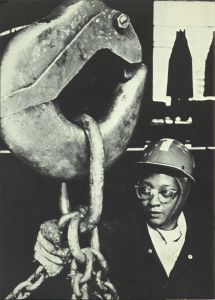
From “Unions on the Line: Myth vs. Reality” by Judy Edelman. Found within Up from Under vol. 1 issue 1
In her article “Unions on the Line: Myth vs. Reality,” published in the feminist journal Up from Under in 1970, Judy Edelman confronts the inequality women faced in the work-force, calling our attention to one of the major issues taken up by Second Wave feminists in the 1970s: the significant wage gap between men and women. In 1970, women earned just 58 cents to every dollar a man made. While Title VII had been passed in 1964, prohibiting employment discrimination based on sex, it was only the beginning of the reform necessary to provide equity in the workplace for women. Edelman’s article, one of many that appeared in the more than one hundred feminist periodicals of the period, presents the numerous myths used to justify discriminatory hiring practices. She goes on to debunk these myths. One mentioned, and a common myth of the period, is that “welfare women don’t want to work. They just want to lie around and collect checks” (34). The author points out that the reality is actually quite different: as Edelman explains, “most women on welfare cannot find jobs which pay enough to keep them alive” (34). The wage gap affects all women, but especially those in the working class because they must work in order to survive. Yet when women are paid “58% as much as men’s wages,” (35) how can they be expected to live above the poverty level? This wage gap effectively forces women to be dependent on men.
Not only are women confronted with unequal treatment and pay at work, but, if they work and also have a husband and family, they are expected to also run the household: “The idea that housework is women’s work is so commonly accepted,” Edelman writes, “that even if a woman works all day she is still expected to shop, cook, clean, and take care of the children” (35-36). Addressing the role women are forced into, this article challenges the very notion of these roles’ existence. These ideas are so “commonly accepted” that people do not question them. Looking more closely at the wage gap, Edelman informs readers that female factory workers “earned a median wage of $3,282” compared to a man’s “$5,752,” while the median pay for women of color was “$2,647” (35). Failing to pay women equally was a profitable business, Edelman argues, as bosses would profit an extra “$60-85 billion per year by paying women less than men” (35).
Edelman’s article goes on to provide information on unions with growing numbers of women, while also contesting unions themselves for their sexist practices. She first commends the United Auto Workers (U.A.W) and the International Union of Electrical workers (I.U.E) for fighting, “consistently for legislation to guarantee full rights and improved conditions for women” (35). U.A.W had “over 200,000 women members” and I.U.E consisted of “a large percentage of women numbers” (35). While these unions were making headway, the larger culture of unions remained sexist. Within the majority of unions, “there [were] no women in positions of leadership” (36). The lack of women in these higher positions allowed their problems to be silenced and ignored. One problem mentioned is that of young mothers who must work, but cannot leave their children alone as “few unions realize the desperate need of young working mothers for child care centers” (35). Failing to elect women to leadership positions widens the gap of inequality, contradicting the baseline ideas of unionization. Women’s underrepresentation further discourages their participation in unions as “most union and community meetings are held at night” (35). This is a problem for women with families, because it is in the evenings when they are expected to perform the duties of a housewife such as cooking dinner. As a result of the sexism in unions, “Out of 28 million working women, only 3.7 million are organized into trade unions” (35). Edelman’s piece, as a whole, works to inform its readers on the importance of educating all women and unions on the vitality of fighting for full equality for women in the workforce.
Edelman, Judy. “Unions on the Line: Myth vs. Reality.” Up from Under, vol. 1, no.1, 1970. (33-37).
